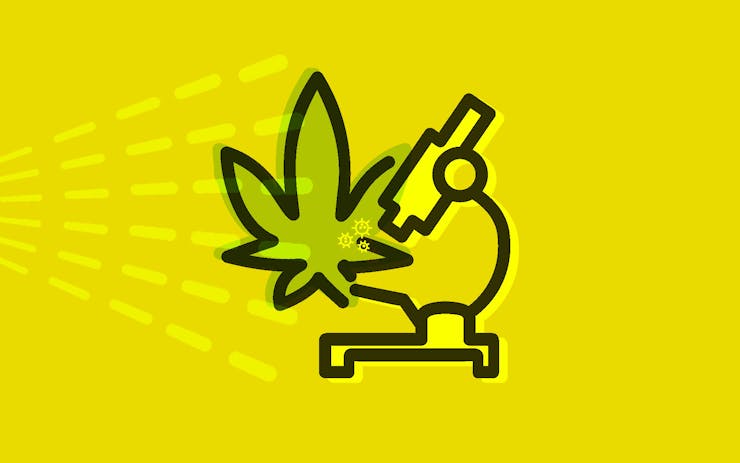When the cannabis legalization wave started, it was naively believed that legal weed would mean clean weed. However, legality hasn’t magically alleviated the hard reality of crop failure, and when you can’t get bank loans, crop insurance, or file for bankruptcy, synthetic pesticides start to look good for a cannabis grower.
Because of the federal prohibition on marijuana, the Environmental Protection Agency (EPA) won’t test the effects of synthetic pesticides on marijuana plants the way it does for other crops. Left on their own, state regulators, who usually have no experience in toxicology, lean toward greatly limiting or banning pesticides because of a lack of research, especially on inhalation.
Without the financial assistance afforded other farmers, cannabis growers feel they shouldn’t be held to such a strict standard. As a result, growers can get around regulations by applying illegal pesticides on the down-low and then use remediation technologies to remove the chemicals after harvest to pass inspection.
But is this practice good, or safe? We’ll talk about why legalization has not stopped the use of synthetic pesticides and how extract remediation, a.k.a. “botanical refinement,” is both helping and hurting the industry.
Why are licensed growers using illegal pesticides?
Many issues make growing cannabis challenging. Unlike farmers in traditional agriculture, cannabis growers go largely unprotected. The lack of access to banking and credit makes starting a cannabis business risky.
Another reason for using pesticides is that the plant itself is prone to many pests, like spider mites, as well as mold and mildew. If not handled correctly, these can completely ruin a crop and even cause illness in humans.
And then there is the overuse of clones. According to Nelson Lindsley of the cannabis consultancy Poetry of Plants, “Clones lose their natural defenses when they are generations from the mother plant and become susceptible to infection by every possible pathogen you can imagine.”
You don’t even have to apply pesticides to have them in your plants. Pesticides in a mother plant can linger for a few generations in clones.
Additionally, pesticides sprayed on nearby agriculture can drift and contaminate legal outdoor cannabis and can stay in the soil for years.
Pesticide remediation technology—how does it work?
Growers can get rid of offending pesticides with remediation technology after cannabis is grown and harvested, but a lot aren’t open about using these technologies because it raises suspicions that they have used illegal pesticides.
Several advanced remediation methods exist today:
- Flash chromatography: One of the most popular techniques, it’s based on compound polarity. Crude cannabis oil is passed through a flash chromatography column and the pure compounds are isolated by a process called selective elution.
- Glass reactor: In this method, cannabis crude oil is run through a glass reactor to pull out water-soluble pesticides. The solvent and cannabis oil are mixed together, and while the oil will not go into the water, water-soluble chemicals like pesticides will precipitate out.
- Pressurized liquid extraction (PLE): This automated technique uses elevated temperature and pressure to achieve extraction, reducing the need for solvents like butane, which increases the rate at which oil is processed.
Why don’t growers use organic methods?
The downside of plant remediation is that it’s allowing growers to use toxins in the environment. It’s hard to quantify how much environmental degradation is happening since the legal industry is not exactly fessing up. Nevertheless, the lack of an environmental assessment of pesticides raises questions about potential effects on the ecosystem.
There are certainly cultivators who grow cannabis organically by using benign organic pesticides and fungicides—neem, kelp, garlic, rosemary, bone meal, and others, but it’s unclear how healthy it is to inhale these substances.
Some growers use an approach called Integrated Pest Management (IPM), an ecosystem-based strategy that focuses on long-term prevention of pests and damage through biological control, habitat manipulation, modification of cultural practices, and the use of resistant plant varieties.
This approach is worth the effort but takes time, education, financial investment, and hard work. “IPM is hard if you have always just sprayed. [It] can take years to figure out, and can be quite expensive to learn,” wrote Jesse Peters, cultivator and CEO of Mantis Growth Investments, in an email to Leafly.
According to Lindsley, IPM is also no guarantee: “With IPM you’re looking at a nine-month, costly battle that you might not win. Meanwhile, the market’s depreciating, taxes are incredibly high, and you’ve got a venture capitalist backer that’s going to bury you if you don’t produce.”
Federal oversight of hemp may bring clearer oversight
As often is the case in the cannabis industry, federal legalization would solve many of these problems: Growers would be more likely to forego pesticides if they were protected financially against crop failure, researchers would study pesticide inhalation, regulators would make evidence-based decisions, and consumers would feel more confident that products were clean.
But until federal legalization happens, it may be hemp that saves the day. Marijuana and hemp are similar plants and now that hemp is legal after the passing of the 2018 Farm Bill, the EPA is scrambling to take the initial steps regarding pesticide use on hemp.
Because of hemp, research on the safety of pesticides on hemp CBD and hemp flower will have to be done, and that may benefit states regulating pesticides for marijuana. But hemp won’t solve the problem of risk. As long as cannabis growers are denied loans, crop insurance, and bankruptcy relief, they’ll take the safe route and spray first and fix it later.
Related articles





